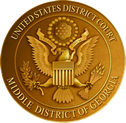


Below is a map of all the district areas for the federal court system. Each area of the country is part of a circuit. Georgia is the 11th Circuit of the federal court system. The link will take you to all of the circuit websites. It will also take you to a list of all of the district offices within each circuit and their websites. Click on the image below to locate federal courts.
Federal courts have jurisdiction over cases involving:
For instance, a claim by an individual to receive money under a federal government program such as Social Security, a claim by the government that someone has violated federal laws, or a challenge to actions taken by a federal agency might all be heard in federal court.
In contrast, most family law matters are addressed in state court, since federal court jurisdiction granted by the U.S. Constitution does not include this area of law.
Few cases wind up in federal trial court, also called U.S. District Court. Judges encourage parties involved in a dispute to reach an agreement and avoid the expense and delay of a trial.
The impact of the federal courts on our lives is best known by landmark Supreme Court cases and other federal court cases that show the judicial branch is significant to the way we live and the rights we have.*
*From the About Federal Courts page
This section of uscourts.gov provides statistical data on the business of the Federal Judiciary. Specific publications address the work of the appellate, district, and bankruptcy courts; the probation and pretrial services systems; and other components of the U.S. courts.
The Federal Court System |
The State Court System |
|
Article III of the Constitution invests the judicial power of the United States in the federal court system. Article III, Section 1 specifically creates the U.S. Supreme Court and gives Congress the authority to create the lower federal courts. |
The Constitution and laws of each state establish the state courts. A court of last resort, often known as a Supreme Court, is usually the highest court. Some states also have an intermediate Court of Appeals. Below these appeals courts are the state trial courts. Some are referred to as Circuit or District Courts. |
|
Congress has used this power to establish the 13 U.S. Courts of Appeals, the 94 U.S. District Courts, the U.S. Court of Claims, and the U.S. Court of International Trade. U.S. Bankruptcy Courts handle bankruptcy cases. Magistrate Judges handle some District Court matters. |
States also usually have courts that handle specific legal matters, e.g., probate court (wills and estates); juvenile court; family court; etc. |
|
Parties dissatisfied with a decision of a U.S. District Court, the U.S. Court of Claims, and/or the U.S. Court of International Trade may appeal to a U.S. Court of Appeals. |
Parties dissatisfied with the decision of the trial court may take their case to the intermediate Court of Appeals. |
|
A party may ask the U.S. Supreme Court to review a decision of the U.S. Court of Appeals, but the Supreme Court usually is under no obligation to do so. The U.S. Supreme Court is the final arbiter of federal constitutional questions. |
Parties have the option to ask the highest state court to hear the case. |
|
Only certain cases are eligible for review by the U.S. Supreme Court. |
The Federal Court System |
The State Court System |
|
The Constitution states that federal judges are to be nominated by the President and confirmed by the Senate. They hold office during good behavior, typically, for life. Through Congressional impeachment proceedings, federal judges may be removed from office for misbehavior. |
State court judges are selected in a variety of ways, including
|
The Federal Court System |
The State Court System |
|
State courts are the final arbiters of state laws and constitutions. Their interpretation of federal law or the U.S. Constitution may be appealed to the U.S. Supreme Court. The Supreme Court may choose to hear or not to hear such cases. |
*Tables copied from Comparing Federal & State Courts - United States Federal Courts
 The Columbus Courthouse, which was built in 1934, is a 3-story building located at the corner of 12th Street and Second Avenue. The building houses the U.S. District Court, U.S. Marshal, U.S. Probation, and U.S. Post Office. The Columbus division serves Chattahoochee, Clay, Harris, Marion, Muscogee, Quitman, Randolph, Stewart, Talbot, and Taylor counties. The U.S. District Court is comprised of five divisions encompassing seventy counties in the state of Georgia with offices in Athens, Albany, Columbus, Macon, and Valdosta.
The Columbus Courthouse, which was built in 1934, is a 3-story building located at the corner of 12th Street and Second Avenue. The building houses the U.S. District Court, U.S. Marshal, U.S. Probation, and U.S. Post Office. The Columbus division serves Chattahoochee, Clay, Harris, Marion, Muscogee, Quitman, Randolph, Stewart, Talbot, and Taylor counties. The U.S. District Court is comprised of five divisions encompassing seventy counties in the state of Georgia with offices in Athens, Albany, Columbus, Macon, and Valdosta.
Street Address:
120 12th Street
Columbus, GA 31902
Mailing Address:
U.S. Post Office & Court House
PO Box 124
Columbus, GA 31902
706-649-7816 (voice)
706-649-7790 (fax)
columbus.ecf@gamd.uscourts.gov
| U.S. District Courts | U.S. District Courts |
|---|---|
| Georgia Middle Georgia Northern Georgia Southern |
Georgia Middle Georgia Northern Georgia Southern |
 Georgia Southern District Court
Georgia Southern District Court Tomochichi United States Courthouse (Headquarters)
125 Bull Street
Savannah, GA 31401
| U.S. District Courts | U.S. District Courts |
|---|---|
| Georgia Middle Georgia Northern Georgia Southern |
Georgia Middle Georgia Northern Georgia Southern |
 All of the Northern District of Georgia Federal courts.
All of the Northern District of Georgia Federal courts.
The Northern District of Georgia was established by Congress in 1849 and consists of forty-six counties (14,258 square miles) in the northwestern part of the state. The district, which includes the Atlanta metropolitan area, has four divisions: Atlanta, Gainesville, Newnan, and Rome.
| U.S. District Courts | U.S. District Courts |
|---|---|
| Georgia Middle Georgia Northern Georgia Southern |
Georgia Middle Georgia Northern Georgia Southern |
 Middle District Court of Alabama (Headquarters) - Montgomery, AL
Middle District Court of Alabama (Headquarters) - Montgomery, AL
The United States District Court for the Middle District of Alabama is one of Alabama’s three judicial districts. The Alabama Middle District covers 23 counties in the central and southeastern parts of the state, and these 23 counties are further segmented into three divisions.
A courthouse is located in each division. The courthouse chosen for a court session depends on a number of factors, including the defendant’s place of residence or the number of defendants. The location may also be selected based on where the incident occurred.
Home to the Frank M. Johnson Jr U.S. Courthouse Complex, Montgomery is the seat of the ALMD Northern Division. The following counties are included in this division: Autauga, Barbour, Bullock, Butler, Chilton, Coosa, Covington, Crenshaw, Elmore, Lowndes, Montgomery, and Pike.
*From the About the Courthouse section
| U.S. District Courts | U.S. Bankruptcy Courts |
|---|---|
| Alabama Middle Alabama Northern Alabama Southern |
Alabama Middle Alabama Northern Alabama Southern |
This U.S. District Court is comprised of five divisions encompassing seventy counties in the state of Georgia with offices in Athens, Albany, Columbus, Macon, and Valdosta.
The United States district courts are the trial courts of the federal court system. Within limits set by Congress and the Constitution, the district courts have jurisdiction to hear nearly all categories of federal cases, including both civil and criminal matters. Every day hundreds of people across the nation are selected for jury duty and help decide some of these cases.
The modern appellate court system comes from The Evarts Act of 1891. The Evarts Act established the structure of the appellate courts -- one court of appeals in every circuit. Over time, Congress expanded the types of cases appellate courts could hear. Click on the video to learn more about the appellate system.
 United States Court of Appeals, Eleventh Circuit (Georgia)
United States Court of Appeals, Eleventh Circuit (Georgia)The 94 U.S. judicial districts are organized into 12 regional circuits, each of which has a United States court of appeals. A court of appeals hears appeals from the district courts located within its circuit, as well as appeals from decisions of federal administrative agencies.
In addition, the Court of Appeals for the Federal Circuit has nationwide jurisdiction to hear appeals in specialized cases, such as those involving patent laws and cases decided by the Court of International Trade and the Court of Federal Claims.
HeinOnline is the world's largest fully searchable, image-based government document and legal research database. It contains comprehensive coverage from inception of both U.S. statutory materials, U.S. Congressional Documents and more than 2,600 scholarly journals, all of the world's constitutions, all U.S. treaties, collections of classic treatises and presidential documents, and access to the full text of state and federal case law powered by Fastcase.
Below are collections CSU students, faculty and friends have access to through HeinOnline. All contain mostly primary source information, published by the government.

Categories to consider looking in the database for are:
| The Supreme Court Library | History of Supreme Court Nominations |
|---|---|
 |
 |